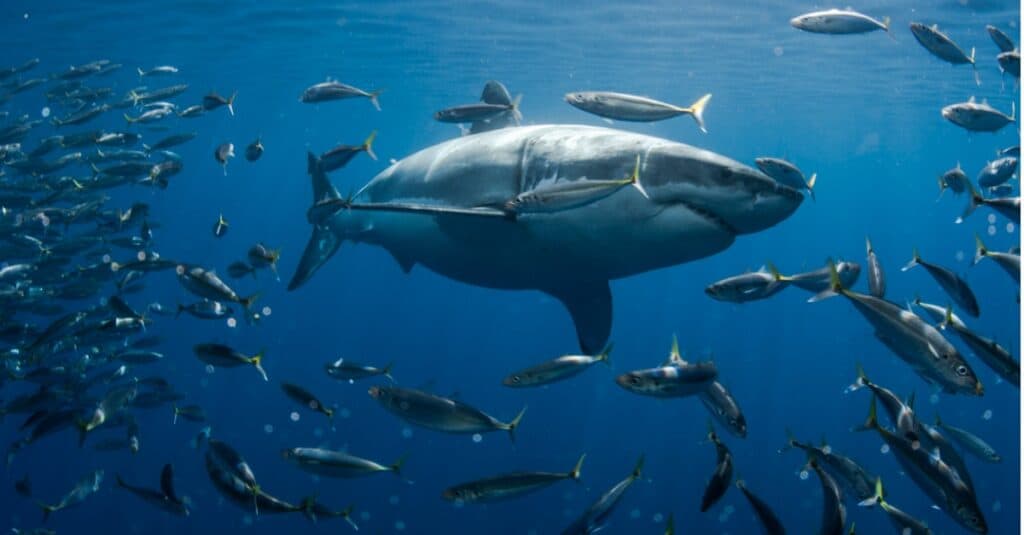The Great Lakes otherwise referred to as the Laurentian Great lakes or the Great Lakes of North America, are a series of deep freshwater lakes in east-central North America interconnected with Lakes Superior, Huron, Ontario, Erie, and Michigan. These lakes hold the largest volume of freshwater globally.
Sharks are wonderful sea creatures popular for their enormous size and staunch predatory tendencies. People often wonder (you may be one of them)–are there sharks in the Great Lakes? Fortunately for you, this article will address that. Let’s go!
Do Sharks Live in the Great Lakes?

Sharks generally do not live in the Great Lakes.
©iStock.com/atese
Sharks do not live in the Great Lakes, but many fishes are mostly drawn to this water body as their natural habitat. Intriguingly, these aquatic animals, to a large extent, seek to leverage the absence of sharks in the Great Lakes to make it a comfortable abode for themselves and their offspring. Fish in the great lakes include:
- Northern pike
- Trout (Brook, rainbow, lake, and brown)
- Bass
- Perch
- Muskellunge
- Salmon (Coho, Chinook, Atlantic, pink)
- Suckers
- Cappie
- Bluegills
- Longnose gar
- American eels
- Bowfin
- Channel catfish
- Lake sturgeon
Of all fish in the Great Lakes, the lake sturgeon is the largest. But, are there sharks in the Great Lakes?
Why Most Sharks Can’t Live in Freshwater

Because they need salty or brackish water to survive, most sharks can not survive in freshwater.
©Vladimir Wrangel/Shutterstock.com
Sharks do not exhibit territorial tendencies like other sea fishes that migrate through water bodies from tropical, polar, and temperate regions. Most aquatic animals are comfortable in freshwater bodies, but that isn’t the case with sharks, as they need salty or brackish water to survive. Unfortunately for sharks, they cannot live in other water bodies void of salty and brackish qualities because freshwater can rupture their cells, cause bloating, and lead to their death.
A study by renowned scientist Adrian C. Gleiss suggests that a deterrent factor exists that can be linked to sharks’ metabolic physiology, which gives insight into the reluctance observed in this group of elasmobranch fishes to adapt to freshwater habitats. While employing hydro-mechanical modeling, Adrian C. Gleiss et al. suggested that the physical properties of freshwater habitats spur a negative value that is translated into the level of buoyancy available.
Sharks depend on their lipid-rich liver to conveniently aid buoyancy when in their normal habitat; this aid is usually seamless because of the physical qualities of the salty or brackish water.
However, in the case of swimming in freshwater habitats, the liver cannot sufficiently provide the same aid for buoyancy because the physical property of the water already sets the buoyancy at an increased negative value. This is simply because the density of a freshwater body is relatively lower than saltwater.
Fortunately, as reported in recent times, only the bull shark, among other sharks, can survive sparingly in freshwater.
How Can Bull Sharks Survive in the Great Lakes?

The salt retention ability of bull sharks can help them survive in the Great Lakes.
©bluehand/Shutterstock.com
Have any sharks ever been spotted in the Great Lakes? Bull sharks have been sighted in the Mississippi River as far north as Illinois, Minnesota, and Wisconsin. However, the cold, fresh water is not sustainable for them to live in.
Bull sharks are members of the elasmobranch fishes believed to enjoy a privileged adaptation that aids their survival in freshwater bodies. One such adaptation is their salt retention ability.
Certain adaptations set bull sharks’ physiological structure a bit above par compared to other elasmobranch fishes – this adaptation helps them retain recycled salt within their bodies. This adaptation also allows them to leverage their salt retention abilities when seeking to prey on little fishes in the Great Lakes.
While bull sharks have evolved to live in freshwater, the reality is that there are no verified reports of sharks in the Great Lakes. While there have been past “sightings,” most have turned out to be pranks or misidentifications. The reality is that the largest of the Great Lakes (Lake Superior and Michigan) are extremely deep lakes that are too cold for sharks. While bull sharks have been reportedly found up to 1,000 miles deep into the Mississippi, the waters are much warmer than the Great Lakes.
What are the 5 Great Lakes?

The Saint Lawrence River is one of the longest rivers in North America, stretching approximately 1,900 miles (3,058 km) from the Great Lakes to the Gulf of St. Lawrence in Canada.
©bulbspark/Shutterstock.com
The Laurentian Great Lakes are so incredibly vast that they consist of five water bodies and even connect to the Atlantic Ocean through the Saint Lawrence River. The comprising lakes include Lake Superior, Lake Michigan, Lake Huron, Lake Erie, and Lake Ontario. It is fitting to note that these waters do not only provide a haven for aquatic life, but they also serve the world economy by aiding the transportation of cargo.
Additionally, there are no sharks in the Great Lakes.
Lake Superior

Lake Superior holds over 10% of the world’s surface fresh water.
©Elena Elisseeva/Shutterstock.com
This large lake has a remarkably high elevation, and it holds over 10% of the total surface of freshwater in the world. The lake’s average temperature cools up to 59° F, making it too cold for a shark to survive therein. The vast border of Lake Superior cuts through Ontario to the North wing while the United States of America clings to the border along with the west and south wings.
Lake Michigan

Lake Michigan has a volume of 1175 cubic miles.
©Sean Pavone/Shutterstock.com
History holds that the lake derives its name from the Ojibwe word ᒥᓯᑲᒥ – mishigami, which means great water. Lake Michigan has a massive volume that makes it the Great Lakes’ second-largest member. Its volume totals 1,175 cubic miles, with the surface area sitting at 22,405 square miles. Lake Michigan has, over time, served as a maritime player, aiding cargo transportation and berthing activities at the ports of Milwaukee and the city of Green Bay.
Lake Huron

Lake Huron takes its name from the inhabitants who lived in the region when the French arrived
©EB Adventure Photography/Shutterstock.com
Lake Huron was named by French explorers who linked the lake to the name of locals who resided in that region; they were known as the Huron people. Lake Huron shares its Northern and Eastern borders with Ontario, while the United States shares the southern and western borders of the lake.
Lake Erie

The shallowest by volume of all the Great Lakes is Lake Erie.
©iStock.com/sara_winter
Lake Erie is the shallowest by volume of all the members of the Great Lakes. Although the fourth largest of the Great Lakes considering its surface area, the lake ranks as the eleventh largest lake globally.
Lake Ontario

Lake Ontario is connected to the Atlantic Ocean via the Saint Lawrence River
©Michael J. Eves/Shutterstock.com
Lake Ontario is the last member of the Great lakes. It shares borders with Ontario, Canada, over a thread of three distinct wings that include the north, west, and southwest regions. The United States also shares borders with this Great Lake in the southern and eastern regions of the lake. It is important to note that the Saint Lawrence River connects Lake Ontario to the Atlantic Ocean.
The photo featured at the top of this post is ©
Thank you for reading! Have some feedback for us? Contact the AZ Animals editorial team.






